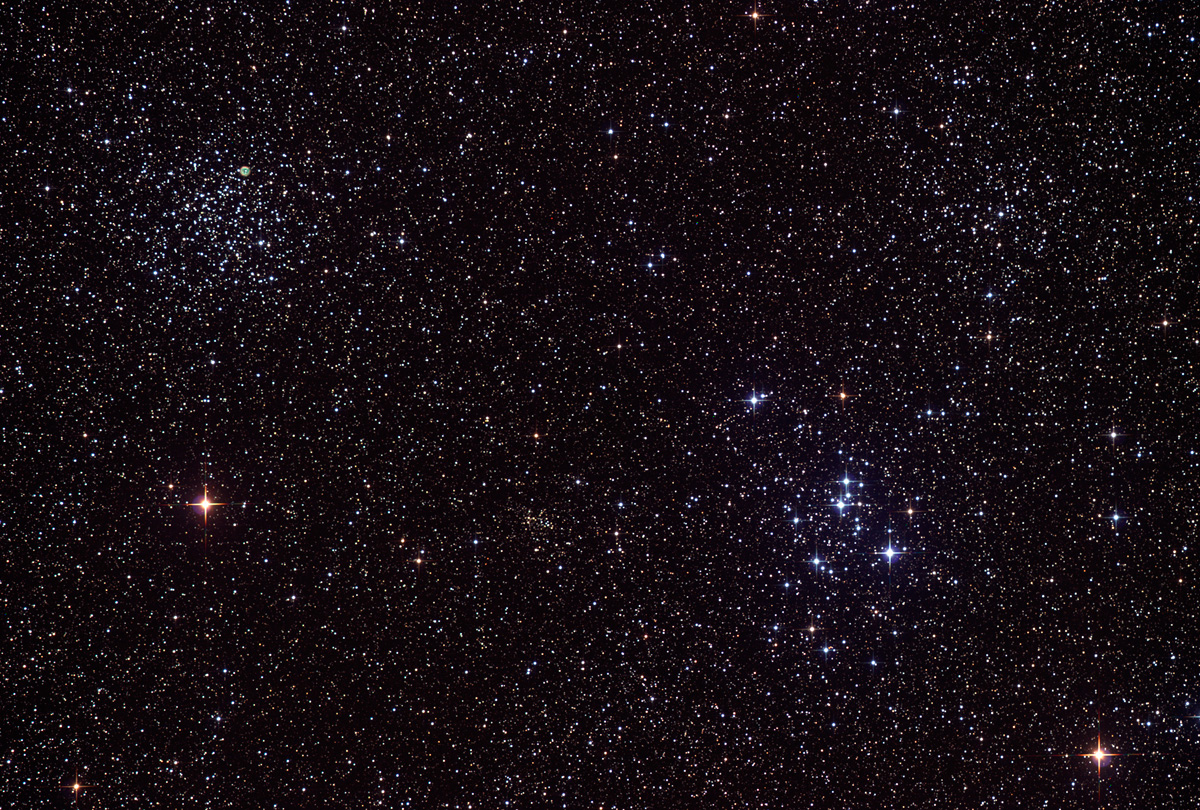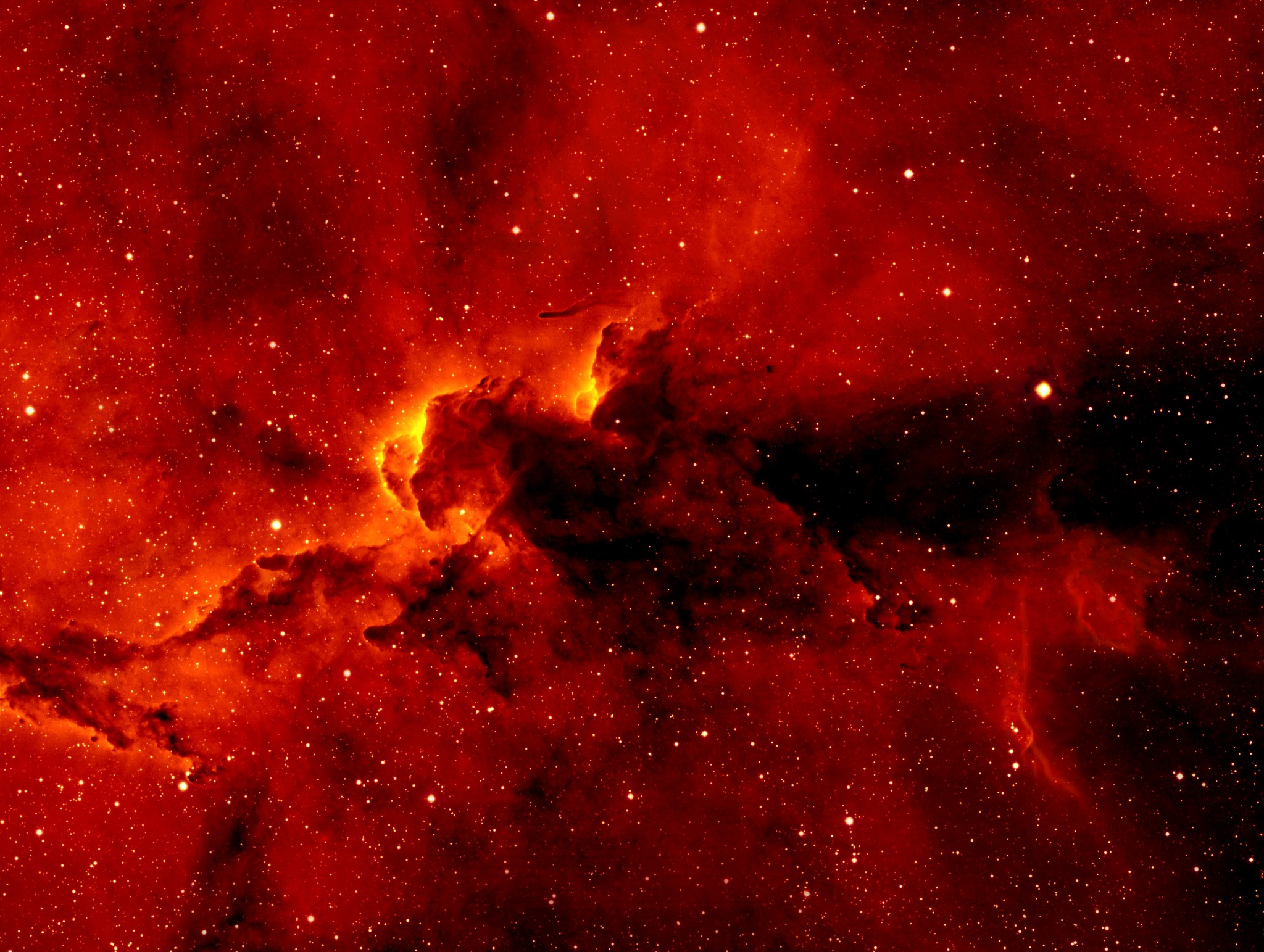Background Stars Young and Old
 Galactic or open star clusters are relatively young swarms of bright stars born together near the plane of our Milky Way Galaxy. Separated by about a degree on the sky, two nice examples are M46 (upper left) 5,400 light-years in the distance and M47 (lower right) only 1,600 light-years away toward the nautical constellation Puppis. Around 300 million years young M46 contains a few hundred stars in a region about 30 light-years across. Aged 80 million years, M47 is a smaller but looser cluster of about 50 stars spanning 10 light-years. But this portrait of stellar youth also contains an ancient interloper. The small, colorful patch of glowing gas in M46 is actually the planetary nebula NGC 2438 - the final phase in the life of a sun-like star billions of years old. NGC 2438 is estimated to be only 3,000 light-years distant and likely represents a foreground object, only by chance appearing along our line of sight to youthful M46.
http://antwrp.gsfc.nasa.gov/apod/ap050804.html
Galactic or open star clusters are relatively young swarms of bright stars born together near the plane of our Milky Way Galaxy. Separated by about a degree on the sky, two nice examples are M46 (upper left) 5,400 light-years in the distance and M47 (lower right) only 1,600 light-years away toward the nautical constellation Puppis. Around 300 million years young M46 contains a few hundred stars in a region about 30 light-years across. Aged 80 million years, M47 is a smaller but looser cluster of about 50 stars spanning 10 light-years. But this portrait of stellar youth also contains an ancient interloper. The small, colorful patch of glowing gas in M46 is actually the planetary nebula NGC 2438 - the final phase in the life of a sun-like star billions of years old. NGC 2438 is estimated to be only 3,000 light-years distant and likely represents a foreground object, only by chance appearing along our line of sight to youthful M46.
http://antwrp.gsfc.nasa.gov/apod/ap050804.html
Text background IC 1396 H-Alpha
 Clouds of glowing hydrogen gas mingle ominously with dark dust lanes in this close-up of IC 1396, an active star forming region some 2,000 light years away in the constellation Cepheus. In this and other similar emission nebulae, energetic ultraviolet light from a hot young star strips electrons from the surrounding hydrogen atoms. As the electrons and atoms recombine they emit longer wavelength, lower energy light in a well known characteristic pattern of bright spectral lines. At visible wavelengths, the strongest emission line in this pattern is in the red part of the spectrum and is known as "Hydrogen-alpha" or just H-alpha. Part of IPHAS, a survey of H-alpha emission in our Milky Way Galaxy, this image spans about 20 light-years and highlights bright, dense regions within IC 1396, likely sites where massive new stars are born.
Clouds of glowing hydrogen gas mingle ominously with dark dust lanes in this close-up of IC 1396, an active star forming region some 2,000 light years away in the constellation Cepheus. In this and other similar emission nebulae, energetic ultraviolet light from a hot young star strips electrons from the surrounding hydrogen atoms. As the electrons and atoms recombine they emit longer wavelength, lower energy light in a well known characteristic pattern of bright spectral lines. At visible wavelengths, the strongest emission line in this pattern is in the red part of the spectrum and is known as "Hydrogen-alpha" or just H-alpha. Part of IPHAS, a survey of H-alpha emission in our Milky Way Galaxy, this image spans about 20 light-years and highlights bright, dense regions within IC 1396, likely sites where massive new stars are born.
Personally, I think that this looks like a man on horseback holding a bow, but Bea insists that it looks like two dragons. Of course, it could just be a random gas cloud… http://antwrp.gsfc.nasa.gov/apod/ap050930.html
Header Eclipsed Moon Montage
 After watching this month's lunar eclipse, amateur astronomer Sebastien Gauthier carefully composed this montage of telescopic images of the Moon sliding through planet Earth's shadow. While the deepest part of the total eclipse corresponds to the central exposure, the play of light across the lunar surface nicely demonstrates that the planet's shadow is not uniformly dark as it extends into space. In fact, lunar maria and montes are still visible in the dimmed, reddened sunlight scattered into the cone-shaped shadow region, or umbra, by Earth's atmosphere. For this eclipse, the Moon's trajectory took it North of the umbra's darker core, seen here cast over the Moon's cratered southern highlands. Gauthier's telescope and camera equipment were set up near the Trois-Rivieres College Champlain Observatory in Quebec, Canada.
http://antwrp.gsfc.nasa.gov/apod/ap030522.html
After watching this month's lunar eclipse, amateur astronomer Sebastien Gauthier carefully composed this montage of telescopic images of the Moon sliding through planet Earth's shadow. While the deepest part of the total eclipse corresponds to the central exposure, the play of light across the lunar surface nicely demonstrates that the planet's shadow is not uniformly dark as it extends into space. In fact, lunar maria and montes are still visible in the dimmed, reddened sunlight scattered into the cone-shaped shadow region, or umbra, by Earth's atmosphere. For this eclipse, the Moon's trajectory took it North of the umbra's darker core, seen here cast over the Moon's cratered southern highlands. Gauthier's telescope and camera equipment were set up near the Trois-Rivieres College Champlain Observatory in Quebec, Canada.
http://antwrp.gsfc.nasa.gov/apod/ap030522.html




No comments:
Post a Comment